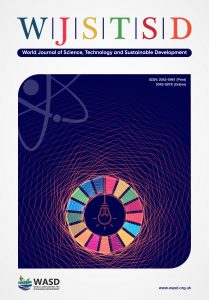Validation of technology push strategies for achieving sustainable development in manufacturing organizations through structural equation modeling, Anuj Singla, Inderpreet Ahuja and APS Sethi
 Anuj Singla
Anuj Singla
Department of Mechanical Engineering
Chandigarh Engineering College, Landran, Mohali
India
Email: anujsingla86@gmail.com
Inderpreet Singh Ahuja
Department of Mechanical Engineering
Punjabi University, Patiala
India
APS Sethi
Department of Mechanical Engineering
Baba Banda Singh Bahadur Engineering College, Fatehgarh Sahib
India
DOI: 10.1108/WJSTSD-08-2017-0022
Purpose: The purpose of this paper is to investigate and select various significant technology push (TP) strategies affecting sustainable development in manufacturing organizations. The study deploys structural equation modeling (SEM) technique to empirically validate the interrelationships amongst significant TP strategies and sustainable development indicators in SEM-TP Model.
Design/methodology/approach: Confirmatory factor analysis approach is utilized to generate an effective SEM-TP Model by using AMOS 21 (Analysis of Moment Structures) software. The data have been collected from different manufacturing organizations practicing TP strategies, using a well-framed TP questionnaire for the evolution of SEM-TP Model.
Findings: SEM modeling of various TP strategies like, innovative capability (IC), research and development, corporate strategy (CS) and export orientation towards achieving sustainable development in manufacturing industries has been performed. SEM-TP Model has been planned and reports obtained before and after modification indices (MI) of the model are correlated, which further establishes improvements in model’s effectiveness. The research concludes that two TP strategies namely, IC and CS are found to be significant in the present context. These strategies have emerged as a foundation for several development initiatives and actively support manufacturing industries in achieving sustainable development. The results obtained from final model may support organizational managers and TP practitioners to improve the overall performance of manufacturing industries involved in the present study. The manufacturing enterprises will be able to frame or enhance their corporate strategies and innovative capabilities in a more appropriate way.
Research limitations/implications: In the present study, contributions of TP practices are determined to accomplish sustainable development in manufacturing industries. Otherwise, issue-wise independent modeling can also be performed to assess the importance of TP practices towards achieving quality and sustainable development under specific orientations.
Practical implications: The research gives priority to enhancement in the coordination among various TP practices and sustainable development parameters in the industries, to inculcate TP as a crucial strategy to meet challenges in global markets.
Social implications: It has been exhibited from model that adequate TP strategies can effectively contribute towards recognition of sustainable development to compete in the highly progressive markets. The results of various interrelationships among TP practices and sustainable development indicators in SEM-TP Model portray the effectiveness of TP practices for accomplishment of organizational and social ambitions.
Originality/value: The outcomes of the study will help organizational managers, HR executives and TP practitioners in manufacturing industries to know about the significant TP strategies to be followed holistically for achieving sustainable development.
Keywords: Sustainable development; Structural equation modeling; Confirmatory factor analysis; Manufacturing industries; Technology push strategies.
Citation: Singla, A., Ahuja, I.S. and Sethi, A. (2018), "Validation of technology push strategies for achieving sustainable development in manufacturing organizations through structural equation modeling", World Journal of Science, Technology and Sustainable Development, Vol. 15 No. 1, pp. 72-93. https://doi.org/10.1108/WJSTSD-08-2017-0022

